Zhangdui Zhong
Channel Semantic Characterization for Integrated Sensing and Communication Scenarios: From Measurements to Modeling
Mar 03, 2025Abstract:With the advancement of sixth-generation (6G) wireless communication systems, integrated sensing and communication (ISAC) is crucial for perceiving and interacting with the environment via electromagnetic propagation, termed channel semantics, to support tasks like decision-making. However, channel models focusing on physical characteristics face challenges in representing semantics embedded in the channel, thereby limiting the evaluation of ISAC systems. To tackle this, we present a novel framework for channel modeling from the conceptual event perspective. By leveraging a multi-level semantic structure and characterized knowledge libraries, the framework decomposes complex channel characteristics into extensible semantic characterization, thereby better capturing the relationship between environment and channel, and enabling more flexible adjustments of channel models for different events without requiring a complete reset. Specifically, we define channel semantics on three levels: status semantics, behavior semantics, and event semantics, corresponding to channel multipaths, channel time-varying trajectories, and channel topology, respectively. Taking realistic vehicular ISAC scenarios as an example, we perform semantic clustering, characterizing status semantics via multipath statistical distributions, modeling behavior semantics using Markov chains for time variation, and representing event semantics through a co-occurrence matrix. Results show the model accurately generates channels while capturing rich semantic information. Moreover, its generalization supports customized semantics.
5G Channel Models for Railway Use Cases at mmWave Band and the Path Towards Terahertz
Jan 28, 2025



Abstract:High-speed trains are one of the most relevant scenarios for the fifth-generation (5G) mobile communications and the "smart rail mobility" vision, where a high-data-rate wireless connectivity with up to several GHz bandwidths will be required. This is a strong motivation for the exploration of millimeter wave (mmWave) band. In this article, we identify the main challenges and make progress towards realistic 5G mmWave channel models for railway use cases. In order to cope with the challenge of including the railway features in the channel models, we define reference scenarios to help the parameterization of channel models for railway use at mmWave band. Simulations and the subsequent measurements used to validate the model reflect the detailed influence of railway objects and the accuracy of the simulations. Finally, we point out the future directions towards the full version of the smart rail mobility which will be powered by terahertz (THz) communications.
Measurement-Based Modeling and Analysis of UAV Air-Ground Channels at 1 and 4 GHz
Jan 28, 2025Abstract:In the design of unmanned aerial vehicle (UAV) wireless communications, a better understanding of propagation characteristics and an accurate channel model are required. Measurements and comprehensive analysis for the UAV-based air-ground (AG) propagation channel in the vertical dimension are presented in this letter. Based on the measurement data at 1 and 4 GHz, the large-scale and small-scale channel parameters are extracted in the line-of-sight (LOS) and nonLOS case, respectively. The altitude-dependent path loss model is proposed herein. Furthermore, shadow fading and fast fading are statistically analyzed for comprehensively describing the fading behavior. Our results will be useful in the modeling of AG channels and the performance analysis for UAV-enabled wireless communication systems.
Vision-Aided Channel Prediction Based on Image Segmentation at Street Intersection Scenarios
Jan 27, 2025Abstract:Intelligent vehicular communication with vehicle road collaboration capability is a key technology enabled by 6G, and the integration of various visual sensors on vehicles and infrastructures plays a crucial role. Moreover, accurate channel prediction is foundational to realizing intelligent vehicular communication. Traditional methods are still limited by the inability to balance accuracy and operability based on substantial spectrum resource consumption and highly refined description of environment. Therefore, leveraging out-of-band information introduced by visual sensors provides a new solution and is increasingly applied across various communication tasks. In this paper, we propose a computer vision (CV)-based prediction model for vehicular communications, realizing accurate channel characterization prediction including path loss, Rice K-factor and delay spread based on image segmentation. First, we conduct extensive vehicle-to-infrastructure measurement campaigns, collecting channel and visual data from various street intersection scenarios. The image-channel dataset is generated after a series of data post-processing steps. Image data consists of individual segmentation of target user using YOLOv8 network. Subsequently, established dataset is used to train and test prediction network ResNet-32, where segmented images serve as input of network, and various channel characteristics are treated as labels or target outputs of network. Finally, self-validation and cross-validation experiments are performed. The results indicate that models trained with segmented images achieve high prediction accuracy and remarkable generalization performance across different streets and target users. The model proposed in this paper offers novel solutions for achieving intelligent channel prediction in vehicular communications.
Channel Spreading Function-Inspired Channel Transfer Function Estimation for OFDM Systems with High-Mobility
Dec 10, 2024


Abstract:In this letter, we propose a novel channel transfer function (CTF) estimation approach for orthogonal frequency division multiplexing (OFDM) systems in high-mobility scenarios, that leverages the stationary properties of the delay-Doppler domain channel spreading function (CSF). First, we develop a CSF estimation model for OFDM systems that relies solely on discrete pilot symbols in the time-frequency (TF) domain, positioned at predefined resource elements. We then present theorems to elucidate the relationship between CSF compactness and pilot spacing in the TF domain for accurate CSF acquisition. Based on the estimated CSF, we finally estimate the CTF for data symbols. Numerical results show that, in high-mobility scenarios, the proposed approach outperforms traditional interpolation-based methods and closely matches the optimal estimator in terms of estimation accuracy. This work may pave the way for CSF estimation in commercial OFDM systems, benefiting high-mobility communications, integrated sensing and communications, and related applications.
GNN-Enabled Optimization of Placement and Transmission Design for UAV Communications
Oct 03, 2024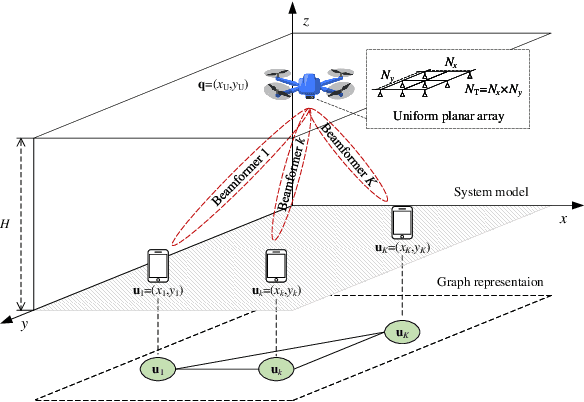
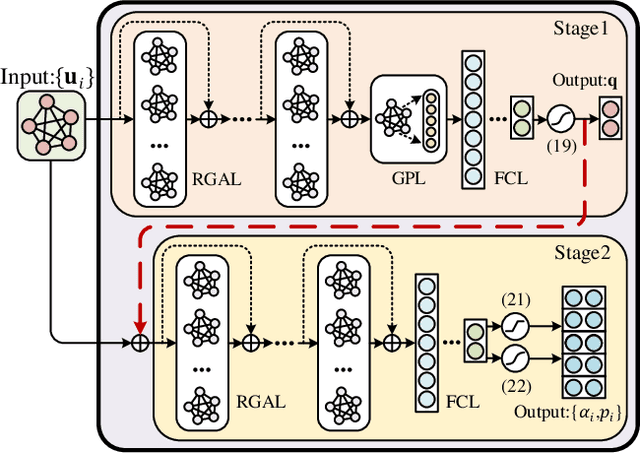
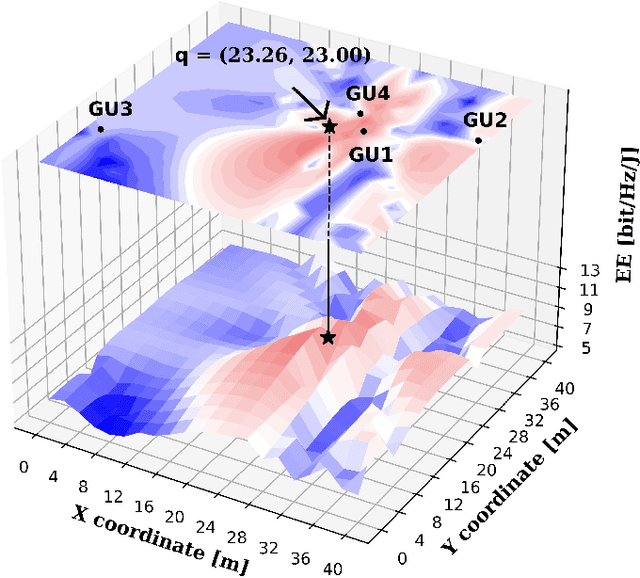
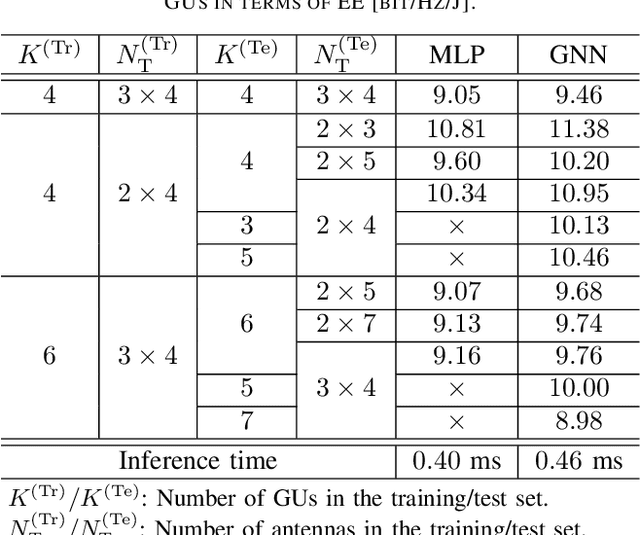
Abstract:This paper applies graph neural networks (GNN) in UAV communications to optimize the placement and transmission design. We consider a multiple-user multiple-input-single-output UAV communication system where a UAV intends to find a placement to hover and serve users with maximum energy efficiency (EE). To facilitate the GNN-based learning, we adopt the hybrid maximum ratio transmission and zero forcing scheme to design the beamforming vectors and a feature augment is implemented by manually setting edge features. Furthermore, we propose a two-stage GNN-based model where the first stage and the second stage yield the placement and the transmission design, respectively. The two stages are connected via a residual and their learnable weights are jointly optimized by via unsupervised learning. Numerical results illustrate the effectiveness and validate the scalability to both UAV antennas and users of the proposed model.
A Cluster-Based Statistical Channel Model for Integrated Sensing and Communication Channels
Mar 01, 2024



Abstract:The emerging 6G network envisions integrated sensing and communication (ISAC) as a promising solution to meet growing demand for native perception ability. To optimize and evaluate ISAC systems and techniques, it is crucial to have an accurate and realistic wireless channel model. However, some important features of ISAC channels have not been well characterized, for example, most existing ISAC channel models consider communication channels and sensing channels independently, whereas ignoring correlation under the consistent environment. Moreover, sensing channels have not been well modeled in the existing standard-level channel models. Therefore, in order to better model ISAC channel, a cluster-based statistical channel model is proposed in this paper, which is based on measurements conducted at 28 GHz. In the proposed model, a new framework based on 3GPP standard is proposed, which includes communication clusters and sensing clusters. Clustering and tracking algorithms are used to extract and analyze ISAC channel characteristics. Furthermore, some special sensing cluster structures such as shared sensing cluster, newborn sensing cluster, etc., are defined to model correlation and difference between communication and sensing channels. Finally, accuracy of the proposed model is validated based on measurements and simulations.
Sum Rate Maximization under AoI Constraints for RIS-Assisted mmWave Communications
Nov 13, 2023



Abstract:The concept of age of information (AoI) has been proposed to quantify information freshness, which is crucial for time-sensitive applications. However, in millimeter wave (mmWave) communication systems, the link blockage caused by obstacles and the severe path loss greatly impair the freshness of information received by the user equipments (UEs). In this paper, we focus on reconfigurable intelligent surface (RIS)-assisted mmWave communications, where beamforming is performed at transceivers to provide directional beam gain and a RIS is deployed to combat link blockage. We aim to maximize the system sum rate while satisfying the information freshness requirements of UEs by jointly optimizing the beamforming at transceivers, the discrete RIS reflection coefficients, and the UE scheduling strategy. To facilitate a practical solution, we decompose the problem into two subproblems. For the first per-UE data rate maximization problem, we further decompose it into a beamforming optimization subproblem and a RIS reflection coefficient optimization subproblem. Considering the difficulty of channel estimation, we utilize the hierarchical search method for the former and the local search method for the latter, and then adopt the block coordinate descent (BCD) method to alternately solve them. For the second scheduling strategy design problem, a low-complexity heuristic scheduling algorithm is designed. Simulation results show that the proposed algorithm can effectively improve the system sum rate while satisfying the information freshness requirements of all UEs.
Reconfigurable Intelligent Surface Assisted High-Speed Train Communications: Coverage Performance Analysis and Placement Optimization
Oct 19, 2023Abstract:Reconfigurable intelligent surface (RIS) emerges as an efficient and promising technology for the next wireless generation networks and has attracted a lot of attention owing to the capability of extending wireless coverage by reflecting signals toward targeted receivers. In this paper, we consider a RIS-assisted high-speed train (HST) communication system to enhance wireless coverage and improve coverage probability. First, coverage performance of the downlink single-input-single-output system is investigated, and the closed-form expression of coverage probability is derived. Moreover, travel distance maximization problem is formulated to facilitate RIS discrete phase design and RIS placement optimization, which is subject to coverage probability constraint. Simulation results validate that better coverage performance and higher travel distance can be achieved with deployment of RIS. The impacts of some key system parameters including transmission power, signal-to-noise ratio threshold, number of RIS elements, number of RIS quantization bits, horizontal distance between base station and RIS, and speed of HST on system performance are investigated. In addition, it is found that RIS can well improve coverage probability with limited power consumption for HST communications.
RIS-assisted High-Speed Railway Integrated Sensing and Communication System
Aug 19, 2023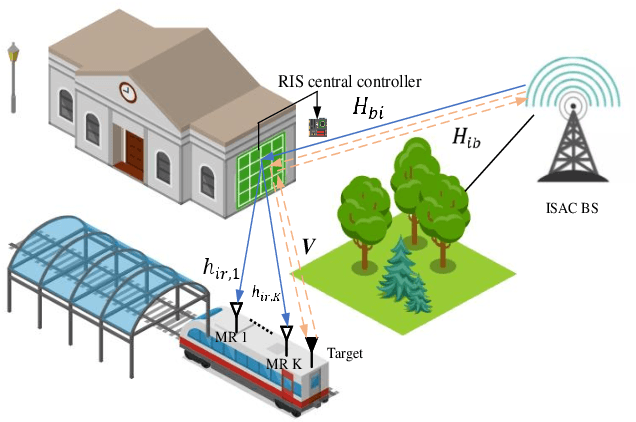
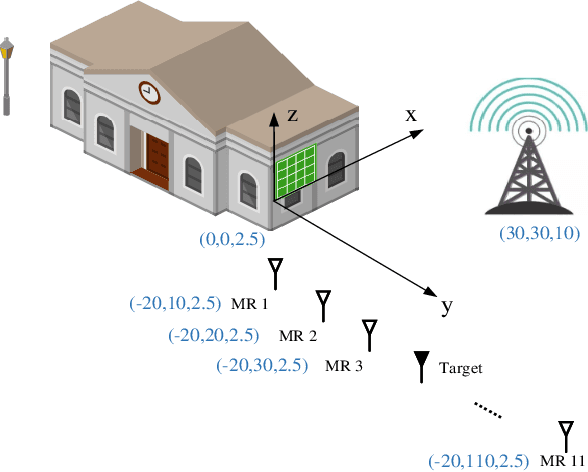
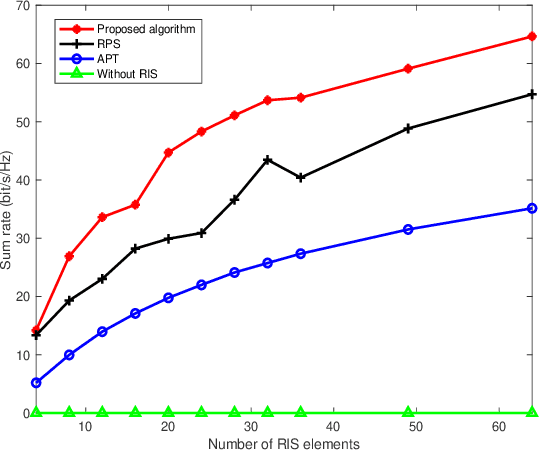
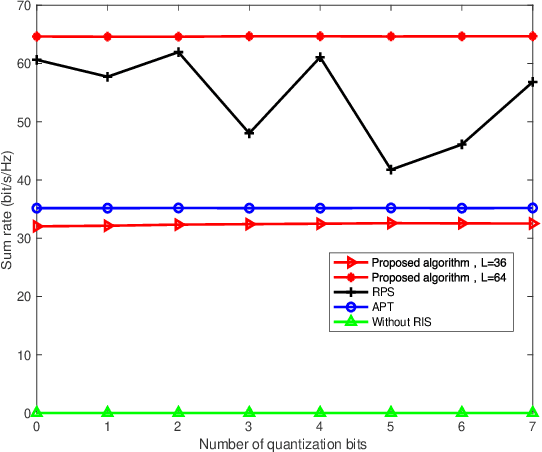
Abstract:One technology that has the potential to improve wireless communications in years to come is integrated sensing and communication (ISAC). In this study, we take advantage of reconfigurable intelligent surface's (RIS) potential advantages to achieve ISAC while using the same frequency and resources. Specifically, by using the reflecting elements, the RIS dynamically modifies the radio waves' strength or phase in order to change the environment for radio transmission and increase the ISAC systems' transmission rate. We investigate a single cell downlink communication situation with RIS assistance. Combining the ISAC base station's (BS) beamforming with RIS's discrete phase shift optimization, while guaranteeing the sensing signal, The aim of optimizing the sum rate is specified. We take advantage of alternating maximization to find practical solutions with dividing the challenge into two minor issues. The first power allocation subproblem is non-convex that CVX solves by converting it to convex. A local search strategy is used to solve the second subproblem of phase shift optimization. According to the results of the simulation, using RIS with adjusted phase shifts can significantly enhance the ISAC system's performance.
 Add to Chrome
Add to Chrome Add to Firefox
Add to Firefox Add to Edge
Add to Edge